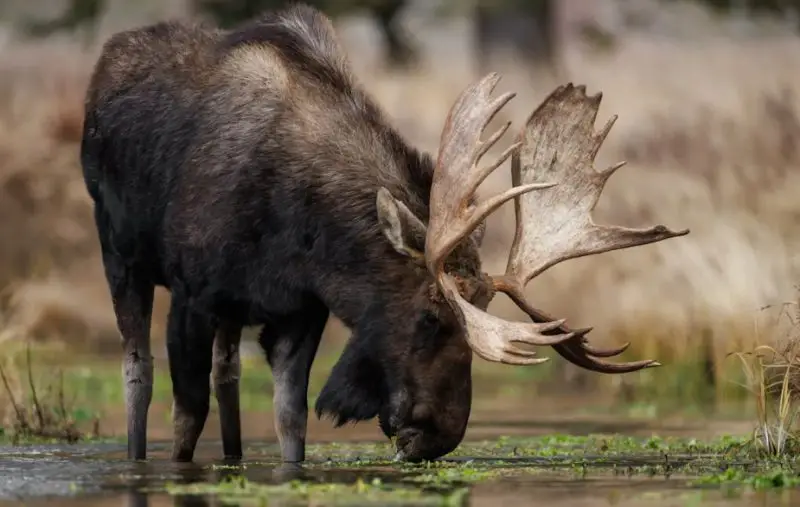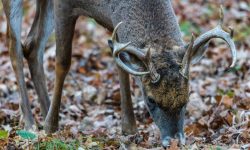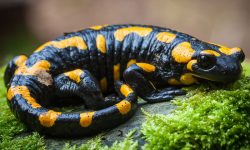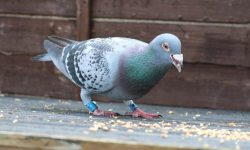Moose are the largest members of the deer family, towering over most other herbivores in the northern forests and wetlands. Their size, strength and cold-weather adaptations allow them to survive in rugged environments from Alaska to Scandinavia. But to maintain such a massive body—sometimes reaching over 1,500 pounds—they must consume an extraordinary amount of food. Understanding what moose eat helps explain how they thrive in harsh climates and how their feeding behavior shapes ecosystems.
Moose follow seasonal patterns in their diet, shifting from tender aquatic plants in summer to woody browse in winter. Their long legs help them move through wetlands, while their flexible lips allow them to strip leaves, pull up roots and snap branches. They are also selective feeders, preferring nutrient-rich vegetation that supports bone density, antler growth and cold-weather endurance.
This guide explores 20 foods moose forage in the wild, offering a detailed look at how these huge herbivores sustain themselves throughout the year. Each food source plays a unique role in keeping moose healthy, resilient and capable of surviving long winters.
Understanding the Moose Diet

Moose are primarily browsers, meaning they feed on leaves, stems, twigs and shoots rather than grazing like bison or elk. Their digestive system is built for extracting nutrients from fibrous vegetation, allowing them to thrive in regions where grasses offer limited value. A moose must consume 30–70 pounds of vegetation per day depending on season, habitat and age.
Their diet varies seasonally. In the summer, moose forage heavily on aquatic plants, young shoots and leafy vegetation that provide essential minerals and hydration. These foods help them store energy for the colder months. In winter, when snow limits food availability, moose shift to bark, twigs and evergreen needles. Although less nutritious, these foods sustain them when other resources disappear.
Moose diets also reflect ecological health. Their foraging behavior shapes forest regeneration and helps maintain wetland diversity. By understanding what moose eat, researchers gain insight into habitat quality, climate response and population trends across their range.
20 Foods Moose Forage in the Wild
1. Willow Shoots
Willow shoots are one of the most important foods for moose throughout the year. These plants grow abundantly along rivers, bogs and moist woodlands where moose spend much of their time. Willow contains high protein and mineral levels that support muscle development and antler growth.
Moose prefer the tender shoots produced in spring and early summer. These young stems are easy to digest and packed with nutrients. Their soft texture makes them especially attractive to calves learning how to browse. During green seasons, moose often spend hours feeding in willow thickets.
In winter, older willow stems provide reliable, though less nutritious, forage. Moose break them with their strong jaws and strip bark to access inner tissues. Willow’s availability throughout the year makes it a staple food for moose.
2. Birch Twigs
Birch trees offer nutrient-rich twigs and buds that moose heavily rely on during winter. Birch forests are ideal moose habitat, providing consistent browse even under thick snow. The thin twigs contain more digestible nutrients than many other winter plants.
Moose break off birch branches using their powerful teeth, often leaving behind characteristic browsing marks. The buds on birch twigs contain stored sugars that help moose maintain energy when temperatures drop. This winter supply helps them survive long periods of limited food availability.
In early spring, birch shoots become especially valuable as they emerge from thawing ground. Moose seek out these fresh growths for renewed nutrients after winter scarcity.
3. Aspen Shoots
Aspen stands attract moose because young shoots grow quickly after disturbance. These shoots are soft, nutrient-rich and easy for moose to digest. In many northern forests, aspens regenerate rapidly, providing a steady supply of food.
Moose browse heavily on aspen shoots during spring and summer. The leaves contain carbohydrates that fuel daily activity, while the stems supply minerals essential for bone strength. Calves in particular benefit from the tender texture of aspen growth.
Because aspen frequently sprouts in large clusters, it creates feeding zones where moose can forage efficiently. These areas help support high populations of moose in mixed forest landscapes.
4. Aquatic Plants
Moose are surprisingly adept swimmers, and they regularly dive into lakes and ponds to feed on aquatic vegetation. These plants supply sodium and other minerals often lacking in terrestrial browse. In some regions, aquatic feeding becomes a daily routine during warm months.
Plants like pondweed, water shield and milfoil form thick underwater mats. Moose use their long legs and flexible lips to pull these plants from the water. The high moisture content helps them stay hydrated in hot weather.
Aquatic foraging also helps moose avoid biting insects. While partially submerged, they feed comfortably and access some of the most nutrient-rich vegetation available to them.
5. Water Lilies
Water lilies offer leaves, stems and roots that moose eagerly consume. Their underwater rhizomes are particularly nutrient-dense, containing carbohydrates that support energy storage for late fall.
Moose dive beneath the surface, pulling up entire plants with their powerful lips. Water lily pads near the surface are also eaten, providing moisture and minerals. This feeding behavior is often seen in summer when lakes produce abundant growth.
The high sodium content of water lilies makes them essential for moose living far from natural salt sources. Their presence supports stronger muscles and prevents mineral deficiencies.
6. Fireweed
Fireweed grows in open meadows, forest clearings and areas recovering from wildfire. These tall pink-flowered plants attract moose with their tender stems and broad leaves rich in nutrients.
Moose feed heavily on fireweed during spring and summer when new shoots emerge. The young plants contain high moisture, helping moose stay hydrated without needing frequent water stops.
As fireweed matures, moose continue to browse on taller stems. Its widespread availability makes it a dependable food wherever disturbance or seasonal growth occurs.
7. Maple Shoots
Maple shoots are nutritious, palatable and widely available across moose habitats. Young maples produce tender leaves and flexible stems that moose can easily strip and consume.
In spring, maple buds swell with stored sugars, making them a high-energy food after winter scarcity. Moose browse these buds intensively, sometimes traveling long distances to reach dense maple stands.
During the rest of the growing season, maple leaves offer moderate nutrients and help round out the moose diet. Their soft texture appeals to both adults and calves.
8. Dogwood Twigs
Dogwood shrubs grow in moist thickets where moose often rest and forage. The twigs contain digestible fiber and minerals that help support winter survival and antler development.
Moose browse dogwood year-round, but consumption increases in winter. The shrubs retain their twigs and buds even under snow, making them a dependable cold-season resource.
Moose often strip entire sections of dogwood in a single feeding session. This efficient browsing makes the plant one of the most important shrubs in their winter diet.
9. Red Osier Dogwood
Red osier dogwood is especially favored during colder months. Its bright red stems stand out in snowy landscapes, and the twigs contain nutrients stored for spring growth.
Moose break off these stems and strip them clean. The plant’s rapid growth allows it to recover quickly, making it a sustainable food source in wetlands and riparian zones.
The high moisture content in dogwood stems also benefits moose when liquid water is scarce in winter.
10. Horsetail Plants
Horsetail plants grow near marshes, riverbanks and damp soil. Moose feed on these ancient plants because they offer silica-rich stems that support bone density and structural strength.
Horsetail shoots appear early in spring, offering one of the first fresh foods moose encounter after winter. Their soft, jointed stems provide moisture and moderate nutrient content.
As horsetail matures, moose continue to browse selectively, often choosing younger stems that remain tender and digestible.
11. Mushroom Varieties
Moose consume mushrooms found on forest floors during late summer and fall. Fungi provide concentrated nutrients including protein, minerals and moisture.
Many mushrooms grow in shaded, moist forest areas where moose spend considerable time. These foods help moose prepare for winter by contributing important trace elements.
Moose selectively forage fungi based on scent and texture. Their digestive system allows them to safely consume varieties that may not be suitable for humans.
12. Balsam Fir
In winter, evergreen trees like balsam fir become vital forage sources. Moose browse needles and twigs when snow covers low-growing vegetation. Though not highly nutritious, evergreen browse provides essential calories for survival.
The strong scent of balsam fir may help moose locate food in deep snow. Moose often target young trees, bending them to reach the most tender shoots.
Because balsam fir remains accessible in harsh winters, it plays a critical role in sustaining moose during extreme conditions.
13. Cedar Needles
Cedar offers evergreen needles that moose consume sparingly. The soft foliage contains oils and nutrients that provide supplemental energy during winter scarcity.
Moose often browse cedar trees when other food options diminish. They pull down branches, eating the fresh tips and discarding tougher stems. In cedar-rich areas, this browsing leaves noticeable patterns on trees.
Although cedar is not a primary food, it fills critical nutritional gaps in late winter.
14. Spruce Tips
Spruce tips are young, soft evergreen shoots that emerge in spring. Moose love these tender growths because they are more digestible than mature needles.
These tips contain high moisture and concentrated nutrients that help moose replenish energy after winter. Calves especially benefit from their softness and mild flavor.
During early spring, moose often move into spruce forests specifically to take advantage of this new growth.
15. Viburnum Shrubs
Viburnum shrubs grow in mixed forests and wetlands. Moose browse their leaves, twigs and occasional berries. These shrubs offer steady summer and fall food.
Moose often target viburnum’s tender new growth. Its nutrient content helps maintain digestive health and energy levels during active seasons.
In autumn, viburnum berries provide an extra burst of carbohydrates. Moose may consume them opportunistically when passing through berry-rich thickets.
16. Cottonwood Leaves
Cottonwood trees produce large, soft leaves that moose enjoy browsing in summer. These leaves contain moisture and carbohydrates that help moose stay hydrated and energized.
Moose often seek shady cottonwood groves to rest and feed during hot days. They strip leaves directly from branches, sometimes snapping limbs to reach higher foliage.
Cottonwood leaves also help support lactating females and growing calves due to their high moisture content.
17. Alder Shoots
Alder grows in wetlands and riversides where moose spend much of their foraging time. The shoots emerge early and remain tender throughout spring and summer.
Moose consume alder for its balanced nutrient profile. The plant’s nitrogen-rich tissues support muscle development and overall strength.
Alder stands regenerate quickly, ensuring a stable supply year after year. Moose browsing helps shape the structure of alder thickets.
18. Wild Berries
Moose occasionally feed on wild berries like blueberries, lingonberries and huckleberries. While not a major food source, berries offer quick energy and hydration during late summer.
These berries grow in forest openings and along ridges where moose often travel. Moose gently nibble clusters, consuming both berries and surrounding leaves.
Berry foraging supplements moose diets with antioxidants and sugars that prepare them for approaching winter.
19. Shrub Bark
In harsh winters, moose peel bark from shrubs and young trees to access inner layers rich in stored nutrients. This behavior becomes more common when deep snow limits access to twigs.
Moose use their incisors to strip bark in long vertical strands. The inner cambium provides small but vital amounts of energy during prolonged cold spells.
While bark is not ideal nutritionally, it helps sustain moose when options are limited.
20. Tree Buds
Tree buds are small but nutrient-dense food sources that appear late in winter and early spring. Moose eagerly search for buds on birch, aspen and willow trees.
These buds contain sugars, oils and proteins essential for recovering from winter stress. Moose often spend hours browsing tree lines before new leaves appear.
Tree buds signal the transition into a more plentiful feeding season, offering a final boost before spring vegetation emerges.
FAQs About What Do Moose Eat
What do moose eat the most?
Willow, birch and aquatic plants are their primary foods depending on season.
Do moose eat grass?
They eat some grasses but prefer leaves, shoots and aquatic plants.
Why do moose eat underwater plants?
Aquatic plants contain sodium and minerals not found on land.
Do moose eat fruit?
Occasionally—they enjoy berries when available.
Can moose digest woody plants?
Yes. Their digestive system is adapted for browsing on twigs and bark.
Do moose change their diet in winter?
Yes. Winter diets rely heavily on twigs, bark and evergreen needles.
How much do moose eat daily?
Between 30 and 70 pounds depending on season and availability.
Do moose eat mushrooms?
Yes, many varieties, especially in late summer and fall.
Are moose herbivores?
Completely—they eat no animal matter.
Why do moose browse shrubs?
Shrubs offer year-round access, even under snow.
Final Thoughts
Moose thrive in some of the world’s harshest climates by relying on diverse plant foods that change with the seasons. Their ability to browse on willow, birch, aquatic vegetation and winter twigs allows them to survive extreme temperatures and deep snow. Understanding what moose eat highlights the delicate balance between wildlife and habitat, revealing how essential healthy wetlands and forests are for sustaining these giants. Moose are symbols of northern wilderness, and their diets reflect the resilience and adaptability that define them.






